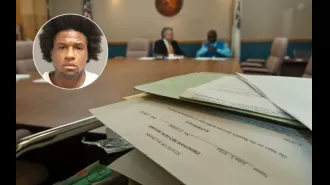FBI-trained expert shares 3 obvious signs of lying based on body language.
Unusual eye movements are a clear sign.
March 19th 2024.

Have you ever noticed how people's eyes tend to blink more when they're talking to you? It's a subtle yet telling sign that something may not be quite right. Scott Taylor, a seasoned security professional with almost 30 years of experience, has an exceptional ability to read body language and detect deception. With an impressive resume that includes working with the FBI and serving as the lead interrogator at Guantanamo Bay, Scott has honed his skills in facial micro-expressions, deception detection, influential behaviors, and statement and word analysis.
According to Scott, there is no single giveaway that someone is lying. Instead, it's a combination of small, subconscious cues that can indicate the truth is being concealed. Among these cues, there are three that are particularly noticeable: fast blinking, lip licking, and hard swallowing. "We normally blink 12 to 14 times per minute, but when we're under stress or feeling anxious, our blink rate increases," Scott explains.
Previous studies have also shown that when people lie, they may blink less than usual before blinking more frequently in what is known as a "compensatory effect." So even if someone appears to be blinking normally while speaking, it's crucial to pay attention to how their eyes react afterwards as well.
In addition to blinking, Scott also points out that lip licking and hard swallowing are major indicators of deception. "When we lie, our bodies release cortisol, the stress hormone, which can cause our mouths to dry up and our saliva production to slow down," he says. These physical reactions are often accompanied by other behaviors, such as touching their face or protecting "power zones" like the chin, stomach, and groin.
In fact, Scott notes that a person who is lying may subconsciously try to hide these areas by dipping their chin or angling their body away from you. These actions can be obvious red flags if you know what to look for.
So, what are some other signs that someone may not be telling the truth? Well, there are a few common behaviors that can be indicative of deception. These include flushing or blushing, lip compression and pulling, changes in eye movements, and the use of overly convincing language, such as "certain," "definite," or "100%." They may also use expanded contractions, like "do not" instead of "don't," and assume language like "you know" or "obviously" in an attempt to sway your opinion.
However, Scott emphasizes that these behaviors should not be taken as definitive proof of deceit. They must be considered as part of a larger pattern of behavior. As we've seen in cases like The Traitors, what we may think are surefire signs of lying can actually be misconceptions.
It's also important to remember that our own biases or preconceived notions about a person can cloud our judgement. And let's not forget that some individuals are just skilled manipulators, able to deceive even the most experienced observers. So before jumping to conclusions, it's important to gather all the facts and approach the situation with an open mind.
Do you have a story about detecting deception or being deceived yourself? We'd love to hear from you! Please email us at [email].
According to Scott, there is no single giveaway that someone is lying. Instead, it's a combination of small, subconscious cues that can indicate the truth is being concealed. Among these cues, there are three that are particularly noticeable: fast blinking, lip licking, and hard swallowing. "We normally blink 12 to 14 times per minute, but when we're under stress or feeling anxious, our blink rate increases," Scott explains.
Previous studies have also shown that when people lie, they may blink less than usual before blinking more frequently in what is known as a "compensatory effect." So even if someone appears to be blinking normally while speaking, it's crucial to pay attention to how their eyes react afterwards as well.
In addition to blinking, Scott also points out that lip licking and hard swallowing are major indicators of deception. "When we lie, our bodies release cortisol, the stress hormone, which can cause our mouths to dry up and our saliva production to slow down," he says. These physical reactions are often accompanied by other behaviors, such as touching their face or protecting "power zones" like the chin, stomach, and groin.
In fact, Scott notes that a person who is lying may subconsciously try to hide these areas by dipping their chin or angling their body away from you. These actions can be obvious red flags if you know what to look for.
So, what are some other signs that someone may not be telling the truth? Well, there are a few common behaviors that can be indicative of deception. These include flushing or blushing, lip compression and pulling, changes in eye movements, and the use of overly convincing language, such as "certain," "definite," or "100%." They may also use expanded contractions, like "do not" instead of "don't," and assume language like "you know" or "obviously" in an attempt to sway your opinion.
However, Scott emphasizes that these behaviors should not be taken as definitive proof of deceit. They must be considered as part of a larger pattern of behavior. As we've seen in cases like The Traitors, what we may think are surefire signs of lying can actually be misconceptions.
It's also important to remember that our own biases or preconceived notions about a person can cloud our judgement. And let's not forget that some individuals are just skilled manipulators, able to deceive even the most experienced observers. So before jumping to conclusions, it's important to gather all the facts and approach the situation with an open mind.
Do you have a story about detecting deception or being deceived yourself? We'd love to hear from you! Please email us at [email].
[This article has been trending online recently and has been generated with AI. Your feed is customized.]
[Generative AI is experimental.]
0
0
Submit Comment





